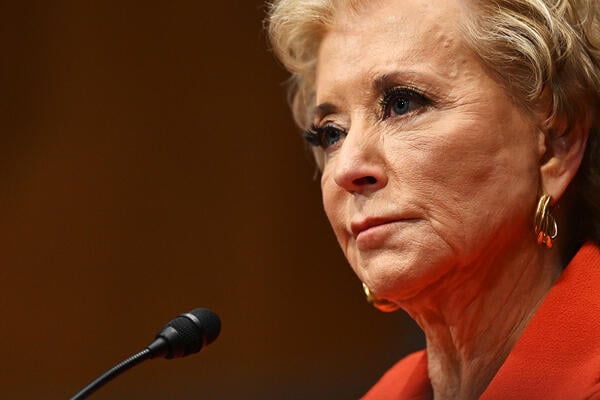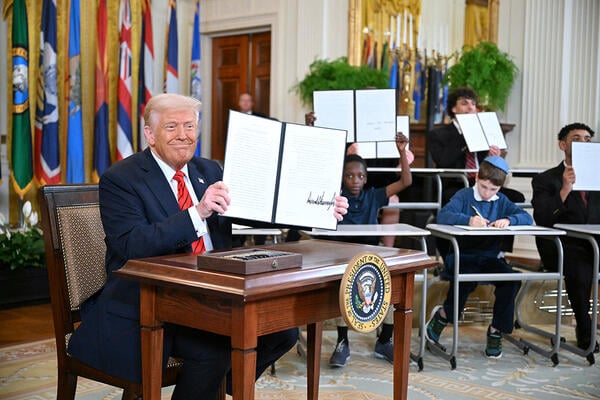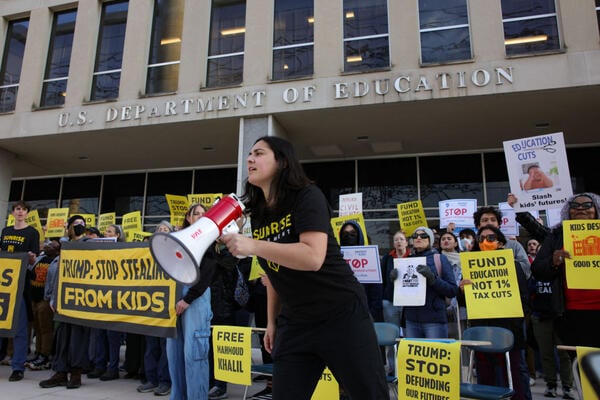Education Secretary Linda McMahon has repeatedly pledged since taking office earlier this month to “get rid of the bureaucracy in education” and “fire herself.”
“When [President Trump] asked me to serve as the secretary of education, I knew exactly what his mandate was—to close the Department of Education,” McMahon said Thursday on a New York radio station, adding that she plans to be “completely transparent with Congress.”
But she’s already laid off nearly half of the agency’s career staff, terminated dozens of contracts and canceled millions in grants without involving Congress, and she’s said those moves are only the beginning.
So, as the Trump administration embarks on a plan to close the department “to the maximum extent of the law,” what more can it do legally? Not even McMahon seems to have the answer.
“One of the things I’ve asked for and is being provided to me is a list of those actions that I can take without Congress, and those that I will need Congress’s approval for” as the department looks to move its core programs to different agencies, she told the radio station. (The department didn’t respond to a request for comment.)
But more than a half dozen higher education scholars, former department staffers and lawyers told Inside Higher Ed that it will be very difficult for the president to wind down or relocate the majority of the department’s operations aside from a few offices, awards and research projects.
Why? Most of its structure and services are written into federal laws that dictate the federal role in higher education and the Education Department’s responsibilities.
For example, the Higher Education Act, first passed in 1965 and amended over the years, authorizes federal student aid programs and outlines the role of states and accreditors in overseeing colleges, including how the government recognizes accrediting agencies. The HEA also authorizes a number of grant programs that directly support institutions, primarily those considered minority-serving.
When Congress created the Education Department in 1979, it gave the agency the authority to administer the programs authorized in the HEA. Previously, the Office of Education—which was part of the Department of Health, Education and Welfare—oversaw those programs.

Education Secretary Linda McMahon wants to put herself out of a job.
Saul Loeb/AFP/Getty Images
The Department of Education Organization Act (DEOA), which also has been amended over the years, defined the purpose of the agency and required certain positions and offices, such as the assistant secretary for civil rights and an inspector general, as well as the Office of Postsecondary Education; the Office for Civil Rights; the Office of Career, Technical and Adult Education; and the Institute of Educational Sciences. (The Office of Federal Student Aid, which oversees federal student aid and loans, was established under the HEA Amendments of 1998.)
“Certainly nothing prevents Congress from passing subsequent laws changing where these functions would be held,” said Katharine Meyer, a fellow of the Brookings Institute’s Brown Center on Education Policy. However, “absent action by Congress, today or going forward, the writing of these bills does not—to me—say that there’s a legal way for an administration to just pick up one office and put it in a different agency.”
That said, some conservative policy experts argue otherwise.
“It doesn’t surprise me that there is not something in law saying how [the department or any of its programs] can be wound down. I don’t know that it is common in federal law for an agency to have written how it would cease to exist,” said Jonathan Butcher, a fellow in education policy at the Heritage Foundation, a conservative think tank that supports closing the department. “At some point, there will need to be something from Congress … but I think that there is enough authority under the secretary to either completely wind down or at least significantly, significantly trim her own agency.”
All of those interviewed did seem to agree on one thing: The Trump administration is going to try and gut the department anyway.
“They’re just pushing the boundaries to see what they can do,” said Daniel Collier, an assistant professor of higher education at the University of Memphis. “They’re saying that they are engaged in this behavior based on the extent of the law. But as you’ll note, they never actually talk about what that law is and what that extent actually looks like. So I’m going to guess that there’s a wide interpretation of what is statutorily required.”
Are Pell Grants Protected?
Among the many programs that the department administers and that are codified in federal law is the Pell Grant program—the single largest source of federal grant aid for college students.
Originally established by Congress in 1972, the Pell Grant program is designed to make postsecondary education more affordable and accessible to low-income students. In fiscal year 2023, more than 6.5 million students received $31 billion in Pell Grants, Congressional Research Service data shows.
Trump has repeatedly said “core necessities” like the Pell Grant program will be “preserved in full,” even if the department goes away. But he suggested earlier this month that it would be among other services “redistributed to various other agencies and departments that will take very good care of them.”
While the president seems confident he can do so without Congress, higher ed policy experts say moving the federal aid program to any other agency would almost certainly violate federal law.
The Higher Education Act specifically says the secretary “shall pay to each eligible institution such sums as may be necessary to pay each eligible student,” referring to Pell Grant payments. Both the HEA and DEOA are clear that when the law mentions “department” and “secretary,” it is referring to the education secretary and the Department of Education.

President Donald Trump signed an executive order on March 20 to start the process of closing the Education Department.
Mandel Ngan/AFP/Getty Images
A lawyer who previously worked in the department and focused on postsecondary education called the text of the HEA a “big blanket” protection for these kinds of functions.
“It’s very black-and-white,” he said. “The secretary is the one who has to make those payments and is responsible for the administration.”
Even Butcher from Heritage said Pell “may not fall under the flexibility” of other the provisions he cites when justifying the secretary’s ability to gut other programs.
Trump hasn’t said where he would move the Pell Grant program.
Can Trump Move Student Loans?
What he does have a plan for, however, is the $1.7 trillion student loan system: He wants the Small Business Administration to take it over “immediately.” Under the HEA, student loans are the education secretary’s responsibility.
Still, Butcher believes that the various subsections of the HEA and other federal laws allow the secretary to transfer the program to another agency.
For student loans specifically, he cited 20 U.S. Code § 1082, which outlines the secretary’s ability to release certain rights regarding federal loans, and 20 U.S. Code § 1087a, which essentially says student loans shall be made by “participating institutions” or “by alternative originators designated by the Secretary.” (The Biden administration also cited parts of 20 U.S. Code § 1082 as its legal authority to forgive billions in student loans under plans that didn’t ultimately move forward.)
Combined, Butcher says, these sections give the secretary authority to either work with other agencies or move the responsibility for administering the loans to other entities—and he believes similar arguments can be made for other services. But he also acknowledged that no one has ever tried to do so.
“So the act of transferring these responsibilities is going to be a matter of determining how a court may read these provisions in HEA about who’s responsible for managing the loans,” he said.
But other experts say that argument is legally shaky.
Meyer from Brookings pointed to the legal precedent set by the Supreme Court striking down Biden’s initial effort to forgive student loans via the HEROES Act.
“The core argument there was that if Congress had wanted to give that authority explicitly to the secretary, they ought to have done so,” Meyer said. “The absence of a prohibition is not tacitly an endorsement of that role.”

Staffing cuts at the Education Department have prompted numerous protests as advocates worry about the agency’s future.
Bryan Dozier/Middle East Images/AFP via Getty Images
More generally, Butcher also pointed to a section of the General Education Provisions Act (GEPA), which was passed in 1967 and contains a broad array of rules applicable to the majority of the department’s programs.
The code authorizes the secretary “to enter into arrangements with other Federal agencies to jointly carry out projects of common interest, to transfer to such agencies funds appropriated under any applicable program, and to receive and use funds from such agencies, for projects of common interest.”
And Butcher said that language may allow the Education Department to move its Office for Civil Rights to the Department of Justice, adding that the Education and Justice Departments often work together. The Office for Civil Rights enforces several federal laws, including Title VI of the Civil Rights Act of 1964, which bars discrimination based on race or national origin, and Title IX of the Education Amendments of 1972, which prohibits sex-based discrimination.
“I think that it’s a reasonable policy and legal or statutory move to say that the Department of Education has decided that these responsibilities are better handled by Justice,” he said.
If the education secretary position ceased to exist and no one was left to re-designate the responsibility, Butcher said that, hopefully, the power should only have to be designated once, “and then it won’t have to be designated again.”
Butcher’s colleague Sarah Parshall Perry, a senior legal fellow at Heritage, said in an email to Inside Higher Ed that “it’s legally questionable—and less likely than not—that the law enforcement powers of OCR could be transferred without Congressional intervention.”
Meyer of Brookings added that GEPA’s “projects of common interest” are not explicitly defined, and that power has generally been used for “stand-alone projects” and “cross-agency initiatives of a smaller scale” often executed through memorandums of understanding.
Collier from the University of Memphis, who specializes in the federal student loan system, said regardless, the lack of clarity likely means nothing to Trump.
He expects the president and McMahon to attempt moving multiple offices, be it FSA or OCR, and argue that the department’s actions are legal. Trump “operates within the ambiguities” and “exists in the murkiness,” he said.
What Could Go Away?
Although McMahon seems to have limited options to legally jettison some of the department’s largest programs, the law does allow her to kill some grants, programs and services.
For instance, the recently passed continuing resolution to keep the government funded through Sept. 30 does give the department more flexibility to move funds around within the same bucket of money.
So theoretically, under the funding legislation, the department could seemingly move funding for the Postsecondary Student Success Grant program and put it toward grants to directly support historically Black colleges and universities. (The Student Success Grant program was created by Congress in 2022 but hasn’t been permanently authorized, making it vulnerable to potential cuts.)
Beyond some of the grant programs, the DEOA generally protects offices outlined in statute, but a provision in one section of the act does give the secretary power to terminate some offices, such as English Language Acquisition or the National Center for Education Statistics. In the recent round of mass layoffs, McMahon fired all staff members of the ELA office and all but three at NCES.
But those programs represent a small sliver of the department’s operations. So what should higher education officials expect next as McMahon continues to comply with Trump’s order to close the department as much as possible? Experts predict dysfunction.
“I don’t believe that they want the Department of Education to work. They are trying to crush it,” said Collier. “But I do know that transferring Pell funds and the student loan debt portfolio are going to come with a lot of glitches and learning curves that are going to affect higher education adversely.”
On top of that, they also expect a plethora of lawsuits. Numerous advocacy groups, teachers’ unions and Democratic-led states have already sued over the layoffs, grant cancellations and Trump’s executive order to close the department, among other issues.
“Absent congressional action, it does not strike me as legal to move something like the student loan program to a different agency. Whether or not the administration may attempt that is a separate question,” Meyer said. “Either way, I expect that if they attempt to do so, it will come up against significant legal challenges and would take quite a long time to resolve.”








